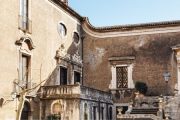Our new guide, a jovial, informative and loquacious Hindu named Jogi was good company. Jogi told us he had met his wife for the first time on their marriage day. Now they were blissfully happy parents of several children. With him we visited Delhi’s Mehrauli Archaeological Park with its Qutub Minar, begun in 1192 and added to over the centuries, its function to call the faithful to prayer, with 379 steps for the muezzin to climb laboriously five times daily, but now closed to the public. Here also is the famous rust-free Iron Pillar, a mystery to metallurgists, since it was made of indestructible unknown alloys as far back as the fourth century. Hinduism, according to Jogi, is not a religion, but a way of life. The greeting Namaste means ‘I see the divine light in you.’ In an attempt to eradicate Hindu belief, the invading Moghuls destroyed idols and statues sacred to Hindus, who believed these each possessed life, which would leave if any were damaged. We were shown evidence of vandalized idols. Between 1296 and 1316, the Moghul Alauddin Khilji butchered thousands of Hindus who had converted to Islam. “He was not a good guy,” said Jogi. It was by then mid-morning and very warm. Tours are cancelled in summer, as it is unbearably hot. Even in May, the temperature can rise to 48 degrees Celsius, and tourists in the park suffer. Jogi remembers an American lady needing four days in hospital to cure her heatstroke. With him we visited the Tomb of Humayun, the second Moghul emperor and father of Akbar the Great, in an impressively fragrant floral garden filled with bougainvillea and frangipani. We declined a suggested visit to the Red Fort built by Shah Jehan when he shifted his capital from Agra to Delhi, because we wanted Jogi to take us to the famous Chandni Chowk market nearby, but before we did so, we contemplated the Red Fort’s moat outside its walls. Once it contained water and crocodiles; now it is a place where pot grows wild and is illegally harvested. We followed the wall to the podium where the Union Jack was hauled down for the last time when India was granted independence in 1947.
Chandni Chowk was a revelation. We took a three-wheeler, all seven of us, including Jogi and the driver, and made our slow way through much of the 12 square kilometers that is the market area. We passed another auto rickshaw whose owner’s sense of humour had emboldened him to paint on its backside “INDIAN FERRARI” in gold lettering. We dismounted when we found ourselves embedded in a traffic jam, and walked unsteadily past an infinite variety of tiny crowded shops selling everything under the sun: spices, nuts, dried fruit, plastic toys, flowers, household goods, cheeses, small appliances and cell phones, past haggling customers, dodging oncoming crowds of pedestrians and the odd scooter making its way along the uneven broken sidewalk. Locals were of course the buyers; tourists mostly came to watch in amazement. Electric cables, hanging down with their great weight between upright hydro poles gave the street a dangerously decrepit look, as did the crumbling jumble of buildings the wires crossed. On the way back to the hotel, we passed the famous “India Gate” an imposing war memorial built to honour Indian troops who served the Empire in the First World War. Parts of New Delhi now housing Indian bureaucracies, designed by Sir Edwin Lutyens and built during the British Raj were most impressively laid out and give the metropolis the dignity a capital city deserves.




